List of birds of South Africa
South Africa is a large country, ranked 25th by size in the world, and is situated in the temperate latitudes and subtropics. Due to a range of climate types present, a patchwork of unique habitat types occur, which contribute to its biodiversity and level of endemism. This list incorporates the mainland and nearshore islands and waters only. The submerged though ecologically important Agulhas Bank is for most part inside its territorial waters. Offshore, South Africa's territory includes the Prince Edward Islands in the Subantarctic Indian Ocean.

This list's taxonomic treatment (designation and sequence of orders, families and species) and nomenclature (English and scientific names) are those of The Clements Checklist of Birds of the World, 2019 edition, except that South African spelling is used.[1] Taxonomic changes are on-going. As more research is gathered from studies of distribution, behaviour and DNA, the order and number of families and species may change. Furthermore, different approaches to ornithological nomenclature have led to concurrent systems of classification (see Sibley-Ahlquist taxonomy and IOU taxonomy).
Unless otherwise noted, the list is that of BirdLife South Africa (BLSA).[2] Notes in the status column are also from this source. Notes of population status, such as "Endangered", refer to the worldwide population, not the South African part of it except for endemics. Unless otherwise noted in the "status" column, the species is a resident or regularly-occurring migrant.
- "Vagrant" means the species rarely or accidentally occurs in South Africa.
- "Endemic" means the species is found only in South Africa.
- "SLE endemic" means the species is found only in South Africa and the Kingdoms of Lesotho and Eswatini (formerly Swaziland). Lesotho is surrounded by South Africa and Eswatini nearly so.
This list contains 854 species according to the Clements taxonomy. The BLSA list includes additional entries as species which Clements considers subspecies; some of them are noted. According to BLSA, 18 species are endemic, 20 are SLE endemic, and 11 have been introduced by humans. Clements describes only 16 as endemic and 15 as SLE endemic. Of the 854 species, 127 are considered vagrants.
Ostriches
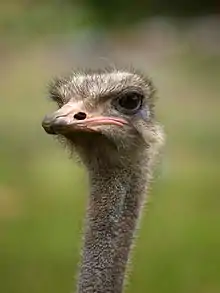
Order: Struthioniformes Family: Struthionidae
Ostriches are flightless birds native to Africa. They are the largest living species of bird. They are distinctive in appearance, with a long neck and legs and the ability to run at high speeds.
| Common name | Binomial | Status |
|---|---|---|
| Common ostrich (South African ostrich) | Struthio camelus (S. c. australis) | |
Ducks, geese, and waterfowl

Order: Anseriformes Family: Anatidae
The family Anatidae includes the ducks and most duck-like waterfowl, such as geese and swans. These are birds adapted to an aquatic existence, with webbed feet, flattened bills, and feathers that are excellent at shedding water due to an oily coating.
| Common name | Binomial | Status |
|---|---|---|
| White-faced whistling-duck | Dendrocygna viduata | |
| Fulvous whistling-duck | Dendrocygna bicolor | |
| White-backed duck | Thalassornis leuconotus | |
| Mute swan | Cygnus olor | Introduced |
| Knob-billed duck | Sarkidiornis melanotos | |
| Egyptian goose | Alopochen aegyptiaca | |
| South African shelduck | Tadorna cana | |
| Spur-winged goose | Plectropterus gambensis | |
| African pygmy-goose | Nettapus auritus | |
| Garganey | Spatula querquedula | |
| Hottentot teal | Spatula hottentota | |
| Cape shoveler | Spatula smithii | |
| African black duck | Anas sparsa | |
| Yellow-billed duck | Anas undulata | |
| Mallard | Anas platyrhynchos | Introduced |
| Cape teal | Anas capensis | |
| Red-billed duck | Anas erythrorhyncha | |
| Northern pintail | Anas acuta | |
| Southern pochard | Netta erythrophthalma | |
| Maccoa duck | Oxyura maccoa | Vulnerable |
Guineafowl
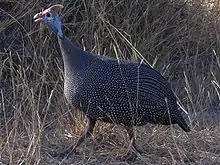
Order: Galliformes Family: Numididae
The guineafowl are a family of birds native to Africa. They typically eat insects and seeds, are ground-nesting, and resemble partridges, except with featherless heads.
| Common name | Binomial | Status |
|---|---|---|
| Helmeted guineafowl | Numida meleagris | |
| Crested guineafowl | Guttera pucherani |
Pheasants, grouse, and allies
.jpg.webp)
Order: Galliformes Family: Phasianidae
The Phasianidae are a family of terrestrial birds consisting of quails, partridges, snowcocks, francolins, spurfowls, tragopans, monals, pheasants, peafowl, and jungle fowls. In general, they are plump and have broad, relatively short wings.
| Common name | Binomial | Status |
|---|---|---|
| Indian peafowl | Pavo cristatus | Introduced |
| Common quail | Coturnix coturnix | |
| Harlequin quail | Coturnix delegorguei | |
| Chukar | Alectoris chukar | Introduced |
| Red-billed francolin | Pternistis adspersus | |
| Cape francolin | Pternistis capensis | See note[notes 1] |
| Natal francolin | Pternistis natalensis | |
| Swainson's francolin | Pternistis swainsonii | |
| Red-necked francolin | Pternistis afer | |
| Crested francolin | Dendroperdix sephaena | |
| Coqui francolin | Peliperdix coqui | |
| Red-winged francolin | Scleroptila levaillantii | |
| Orange River francolin | Scleroptila gutturalis | |
| Grey-winged francolin | Scleroptila africanus | SLE endemic |
| Shelley's francolin | Scleroptila shelleyi |
Flamingos
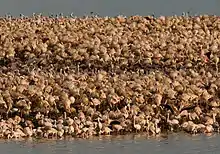
Order: Phoenicopteriformes Family: Phoenicopteridae
Flamingos are large gregarious wading birds found in both the Western and Eastern Hemispheres. Flamingos filter-feed on shellfish and algae. Their oddly shaped beaks are specially adapted to separate mud and silt from the food they consume and, uniquely, are used upside-down.
| Common name | Binomial | Status |
|---|---|---|
| Greater flamingo | Phoenicopterus roseus | |
| Lesser flamingo | Phoeniconaias minor | Near threatened |
Grebes
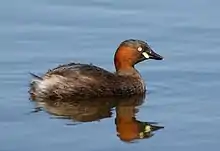
Order: Podicipediformes Family: Podicipedidae
Grebes are small to medium-large freshwater diving birds. They have lobed toes and are excellent swimmers and divers. However, they have their feet placed far back on the body, making them quite ungainly on land.
| Common name | Binomial | Status |
|---|---|---|
| Little grebe | Tachybaptus ruficollis | |
| Great crested grebe | Podiceps cristatus | |
| Eared grebe | Podiceps nigricollis |
Pigeons and doves
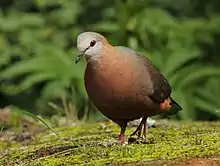
Order: Columbiformes Family: Columbidae
Pigeons and doves are stout-bodied birds with short necks and short slender bills with a fleshy cere.
| Common name | Binomial | Status |
|---|---|---|
| Rock pigeon | Columba livia | Introduced |
| Speckled pigeon | Columba guinea | |
| Rameron pigeon | Columba arquatrix | |
| Delegorgue's pigeon | Columba delegorguei | |
| Lemon dove | Columba larvata | |
| European turtle-dove | Streptopelia turtur | Vagrant; vulnerable |
| Mourning collared-dove | Streptopelia decipiens | |
| Red-eyed dove | Streptopelia semitorquata | |
| Ring-necked dove | Streptopelia capicola | |
| Laughing dove | Streptopelia senegalensis | |
| Emerald-spotted wood-dove | Turtur chalcospilos | |
| Blue-spotted wood-dove | Turtur afer | |
| Tambourine dove | Turtur tympanistria | |
| Namaqua dove | Oena capensis | |
| African green-pigeon | Treron calvus |
Sandgrouse
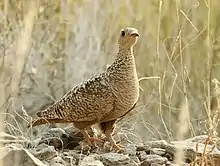
Order: Pterocliformes Family: Pteroclidae
Sandgrouse have small, pigeon-like heads and necks, but sturdy compact bodies. They have long pointed wings and sometimes tails and a fast direct flight. Flocks fly to watering holes at dawn and dusk. Their legs are feathered down to the toes.
| Common name | Binomial | Status |
|---|---|---|
| Namaqua sandgrouse | Pterocles namaqua | |
| Yellow-throated sandgrouse | Pterocles gutturalis | |
| Double-banded sandgrouse | Pterocles bicinctus | |
| Burchell's sandgrouse | Pterocles burchelli |
Bustards
.jpg.webp)
Order: Otidiformes Family: Otididae
Bustards are large terrestrial birds mainly associated with dry open country and steppes in the Old World. They are omnivorous and nest on the ground. They walk steadily on strong legs and big toes, pecking for food as they go. They have long broad wings with "fingered" wingtips and striking patterns in flight. Many have interesting mating displays.
| Common name | Binomial | Status |
|---|---|---|
| Kori bustard | Ardeotis kori | Near threatened |
| Ludwig's bustard | Neotis ludwigii | Endangered |
| Denham's bustard | Neotis denhami | Near threatened |
| White-bellied bustard | Eupodotis senegalensis | |
| Blue bustard | Eupodotis caerulescens | SLE endemic (see note);[notes 2] near threatened |
| Karoo bustard | Eupodotis vigorsii | |
| Red-crested bustard | Eupodotis ruficrista | |
| Black bustard | Eupodoti afra | Endemic; vulnerable |
| White-quilled bustard | Eupodoti afraoides | |
| Black-bellied bustard | Lissotis melanogaster |
Turacos
Order: Musophagiformes Family: Musophagidae
The turacos, plantain eaters, and go-away-birds make up the family Musophagidae. They are medium-sized arboreal birds. The turacos and plantain eaters are brightly coloured, usually in blue, green, or purple. The go-away-birds are mostly grey and white.
| Common name | Binomial | Status |
|---|---|---|
| Livingstone's turaco | Tauraco livingstonii | |
| Knysna turaco | Tauraco corythaix | SLE endemic |
| Purple-crested turaco | Tauraco porphyreolophus | |
| Grey go-away-bird | Corythaixoides concolor |
Cuckoos
Order: Cuculiformes Family: Cuculidae
The family Cuculidae includes cuckoos, roadrunners, and anis. These birds are of variable size with slender bodies, long tails, and strong legs.
| Common name | Binomial | Status |
|---|---|---|
| Senegal coucal | Centropus senegalensis | |
| White-browed coucal | Centropus superciliosus | |
| Black coucal | Centropus grillii | |
| Green malkoha | Ceuthmochares australis | |
| Great spotted cuckoo | Clamator glandarius | |
| Levaillant's cuckoo | Clamator levaillantii | |
| Pied cuckoo | Clamator jacobinus | |
| Thick-billed cuckoo | Pachycoccyx audeberti | |
| Dideric cuckoo | Chrysococcyx caprius | |
| Klaas's cuckoo | Chrysococcyx klaas | |
| African emerald cuckoo | Chrysococcyx cupreus | |
| Barred long-tailed cuckoo | Cercococcyx montanus | Vagrant |
| Black cuckoo | Cuculus clamosus | |
| Red-chested cuckoo | Cuculus solitarius | |
| African cuckoo | Cuculus gularis | |
| Madagascar cuckoo | Cuculus rochii | Vagrant |
| Common cuckoo | Cuculus canorus |
Nightjars and allies
Order: Caprimulgiformes Family: Caprimulgidae
Nightjars are medium-sized ground-nesting nocturnal birds with long wings, short legs, and very short bills. Most have small feet, of little use for walking, and long pointed wings. Their soft plumage is camouflaged to resemble bark or leaves.
| Common name | Binomial | Status |
|---|---|---|
| Pennant-winged nightjar | Caprimulgus vexillarius | |
| Eurasian nightjar | Caprimulgus europaeus | |
| Rufous-cheeked nightjar | Caprimulgus rufigena | |
| Fiery-necked nightjar | Caprimulgus pectoralis | |
| Swamp nightjar | Caprimulgus natalensis | |
| Freckled nightjar | Caprimulgus tristigma | |
| Square-tailed nightjar | Caprimulgus fossii |
Swifts
Order: Caprimulgiformes Family: Apodidae
Swifts are small birds which spend the majority of their lives flying. These birds have very short legs and never settle voluntarily on the ground, perching instead only on vertical surfaces. Many swifts have long swept-back wings which resemble a crescent or boomerang.
| Common name | Binomial | Status |
|---|---|---|
| Mottled spinetail | Telacanthura ussheri | |
| Bat-like spinetail | Neafrapus boehmi | |
| Alpine swift | Apus melba | |
| Common swift | Apus apus | |
| African swift | Apus barbatus | |
| Bradfield's swift | Apus bradfieldi | |
| Little swift | Apus affinis | |
| Horus swift | Apus horus | |
| White-rumped swift | Apus caffer | |
| African palm-swift | Cypsiurus parvus |
Flufftails
Order: Gruiformes Family: Sarothruridae
The flufftails are a small family of ground-dwelling birds found only in Madagascar and sub-Saharan Africa.
| Common name | Binomial | Status |
|---|---|---|
| Buff-spotted flufftail | Sarothrura elegans | |
| Red-chested flufftail | Sarothrura rufa | |
| Streaky-breasted flufftail | Sarothrura boehmi | Vagrant |
| Striped flufftail | Sarothrura affinis | |
| White-winged flufftail | Sarothrura ayresi | Critically endangered |
Rails, gallinules, and coots
.jpg.webp)
Order: Gruiformes Family: Rallidae
Rallidae is a large family of small to medium-sized birds which includes the rails, crakes, coots, and gallinules. Typically they inhabit dense vegetation in damp environments near lakes, swamps, or rivers. In general they are shy and secretive birds, making them difficult to observe. Most species have strong legs and long toes which are well adapted to soft uneven surfaces. They tend to have short, rounded wings and to be weak fliers.
| Common name | Binomial | Status |
|---|---|---|
| African rail | Rallus caerulescens | |
| Corn crake | Crex crex | |
| African crake | Crex egregia | |
| Spotted crake | Porzana porzana | |
| Lesser moorhen | Paragallinula angulata | |
| Eurasian moorhen | Gallinula chloropus | |
| Red-knobbed coot | Fulica cristata | |
| Allen's gallinule | Porphyrio alleni | |
| Purple gallinule | Porphyrio martinica | Vagrant |
| African swamphen | Porphyrio madagascariensis | |
| Striped crake | Amaurornis marginalis | |
| Black crake | Zapornia flavirostra | |
| Little crake | Zapornia parva | Vagrant |
| Baillon's crake | Zapornia pusilla |
Finfoots
Order: Gruiformes Family: Heliornithidae
Heliornithidae is a small family of tropical birds with webbed lobes on their feet similar to those of grebes and coots.
| Common name | Binomial | Status |
|---|---|---|
| African finfoot | Podica senegalensis |
Cranes

Order: Gruiformes Family: Gruidae
Cranes are large, long-legged, and long-necked birds. Unlike the similar-looking but unrelated herons, cranes fly with necks outstretched, not pulled back. Most have elaborate and noisy courting displays or "dances".
| Common name | Binomial | Status |
|---|---|---|
| Grey crowned-crane | Balearica regulorum | Endangered |
| Blue crane | Anthropoides paradiseus | Vulnerable |
| Wattled crane | Bugeranus carunculatus | Vulnerable |
Sheathbills
Order: Charadriiformes Family: Chionidae
The two species in this family breed on Antarctica and islands near that continent.
| Common name | Binomial | Status |
|---|---|---|
| Snowy sheathbill | Chionis alba | Vagrant |
Thick-knees

Order: Charadriiformes Family: Burhinidae
The stone-curlews and thick-knees are a group of largely tropical waders in the family Burhinidae. They are found worldwide within the tropical zone, with some species also breeding in temperate Europe and Australia. They are medium to large waders with strong black or yellow-black bills, large yellow eyes, and cryptic plumage. Despite being classed as waders, most species have a preference for arid or semi-arid habitats.
| Common name | Binomial | Status |
|---|---|---|
| Water thick-knee | Burhinus vermiculatus | |
| Spotted thick-knee | Burhinus capensis |
Stilts and avocets
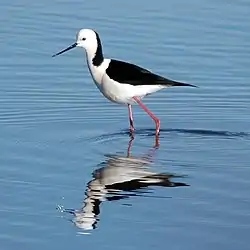
Order: Charadriiformes Family: Recurvirostridae
Recurvirostridae is a family of large wading birds, which includes the avocets and stilts. The avocets have long legs and long up-curved bills. The stilts have extremely long legs and long, thin, straight bills.
| Common name | Binomial | Status |
|---|---|---|
| Black-winged stilt | Himantopus himantopus | |
| Pied avocet | Recurvirostra avosetta |
Oystercatchers
Order: Charadriiformes Family: Haematopodidae
The oystercatchers are large and noisy plover-like birds, with strong bills used for smashing or prising open molluscs.
| Common name | Binomial | Status |
|---|---|---|
| Eurasian oystercatcher | Haematopus ostralegus | Vagrant; near threatened |
| African oystercatcher | Haematopus moquini |
Plovers and lapwings
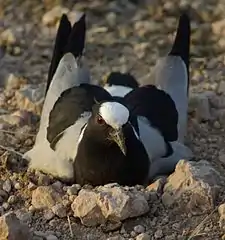
Order: Charadriiformes Family: Charadriidae
The family Charadriidae includes the plovers, dotterels, and lapwings. They are small to medium-sized birds with compact bodies, short thick necks, and long, usually pointed, wings. They are found in open country worldwide, mostly in habitats near water.
| Common name | Binomial | Status |
|---|---|---|
| Black-bellied plover | Pluvialis squatarola | |
| American golden-plover | Pluvialis dominica | Vagrant |
| Pacific golden-plover | Pluvialis fulva | Vagrant |
| Long-toed lapwing | Vanellus crassirostris | Vagrant |
| Blacksmith lapwing | Vanellus armatus | |
| White-headed lapwing | Vanellus albiceps | |
| Senegal lapwing | Vanellus lugubris | |
| Black-winged lapwing | Vanellus melanopterus | |
| Crowned lapwing | Vanellus coronatus | |
| Wattled lapwing | Vanellus senegallus | |
| Lesser sand-plover | Charadrius mongolus | |
| Greater sand-plover | Charadrius leschenaultii | |
| Caspian plover | Charadrius asiaticus | |
| Kittlitz's plover | Charadrius pecuarius | |
| Common ringed plover | Charadrius hiaticula | |
| Little ringed plover | Charadrius dubius | Vagrant |
| Three-banded plover | Charadrius tricollaris | |
| White-fronted plover | Charadrius marginatus | |
| Chestnut-banded plover | Charadrius pallidus | Near threatened |
Painted-snipes
Order: Charadriiformes Family: Rostratulidae
Painted-snipe are short-legged, long-billed birds similar in shape to the true snipes, but more brightly coloured.
| Common name | Binomial | Status |
|---|---|---|
| Greater painted-snipe | Rostratula benghalensis |
Jacanas
Order: Charadriiformes Family: Jacanidae
The jacanas are a group of waders found throughout the tropics. They are identifiable by their huge feet and claws which enable them to walk on floating vegetation in the shallow lakes that are their preferred habitat.
| Common name | Binomial | Status |
|---|---|---|
| Lesser jacana | Microparra capensis | |
| African jacana | Actophilornis africanus |
Sandpipers and allies

Order: Charadriiformes Family: Scolopacidae
Scolopacidae is a large diverse family of small to medium-sized shorebirds including the sandpipers, curlews, godwits, shanks, tattlers, woodcocks, snipes, dowitchers, and phalaropes. The majority of these species eat small invertebrates picked out of the mud or soil. Variation in length of legs and bills enables multiple species to feed in the same habitat, particularly on the coast, without direct competition for food.
| Common name | Binomial | Status |
|---|---|---|
| Whimbrel | Numenius phaeopus | |
| Eurasian curlew | Numenius arquata | Near threatened |
| Bar-tailed godwit | Limosa lapponica | Near threatened |
| Black-tailed godwit | Limosa limosa | Vagrant; near threatened |
| Hudsonian godwit | Limosa haemastica | Vagrant |
| Ruddy turnstone | Arenaria interpres | |
| Great knot | Calidris tenuirostris | Vagrant; endangered |
| Red knot | Calidris canutus | Near threatened |
| Ruff | Calidris pugnax | |
| Broad-billed sandpiper | Calidris falcinellus | Vagrant |
| Curlew sandpiper | Calidris ferruginea | Near threatened |
| Temminck's stint | Calidris temminckii | Vagrant |
| Long-toed stint | Calidris subminuta | Vagrant |
| Red-necked stint | Calidris ruficollis | Vagrant; near threatened |
| Sanderling | Calidris alba | |
| Dunlin | Calidris alpina | Vagrant |
| Baird's sandpiper | Calidris bairdii | Vagrant |
| Little stint | Calidris minuta | |
| White-rumped sandpiper | Calidris fuscicollis | Vagrant |
| Buff-breasted sandpiper | Calidris subruficollis | Vagrant; near threatened |
| Pectoral sandpiper | Calidris melanotos | Vagrant |
| Asian dowitcher | Limnodromus semipalmatus | Vagrant; near threatened |
| Great snipe | Gallinago media | Vagrant; near threatened |
| African snipe | Gallinago nigripennis | |
| Terek sandpiper | Xenus cinereus | |
| Wilson's phalarope | Phalaropus tricolor | Vagrant |
| Red-necked phalarope | Phalaropus lobatus | Vagrant; near-threatened |
| Red phalarope | Phalaropus fulicarius | |
| Common sandpiper | Actitis hypoleucos | |
| Green sandpiper | Tringa ochropus | |
| Spotted redshank | Tringa erythropus | Vagrant |
| Common greenshank | Tringa nebularia | |
| Lesser yellowlegs | Tringa flavipes | Vagrant |
| Marsh sandpiper | Tringa stagnatilis | |
| Wood sandpiper | Tringa glareola | |
| Common redshank | Tringa totanus |
Buttonquail
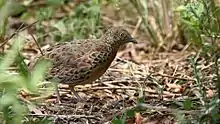
Order: Charadriiformes Family: Turnicidae
The buttonquails are small, drab, running birds which resemble the true quails. The female is the brighter of the sexes and initiates courtship. The male incubates the eggs and tends the young.
| Common name | Binomial | Status |
|---|---|---|
| Small buttonquail | Turnix sylvaticus | |
| Black-rumped buttonquail | Turnix nanus | |
| Hottentot buttonquail | Turnix hottentottus | Endemic |
Crab-plover
Order: Charadriiformes Family: Dromadidae
The crab-plover is related to the waders. It resembles a plover but with very long grey legs and a strong heavy black bill similar to a tern's. It has black-and-white plumage, a long neck, partially webbed feet, and a bill designed for eating crabs.
| Common name | Binomial | Status |
|---|---|---|
| Crab-plover | Dromas ardeola | Vagrant |
Pratincoles and coursers
_(32854371542).jpg.webp)
Order: Charadriiformes Family: Glareolidae
Glareolidae is a family of wading birds comprising the pratincoles, which have short legs, long pointed wings, and long forked tails, and the coursers, which have long legs, short wings, and long, pointed bills which curve downwards.
| Common name | Binomial | Status |
|---|---|---|
| Burchell's courser | Cursorius rufus | |
| Temminck's courser | Cursorius temminckii | |
| Double-banded courser | Smutsornis africanus | |
| Three-banded courser | Rhinoptilus cinctus | |
| Bronze-winged courser | Rhinoptilus chalcopterus | |
| Collared pratincole | Glareola pratincola | |
| Black-winged pratincole | Glareola nordmanni | Near threatened |
| Rock pratincole | Glareola nuchalis | Vagrant |
Skuas and jaegers
Order: Charadriiformes Family: Stercorariidae
The family Stercorariidae are, in general, medium to large birds, typically with grey or brown plumage, often with white markings on the wings. They nest on the ground in temperate and arctic regions and are long-distance migrants.
| Common name | Binomial | Status |
|---|---|---|
| South polar skua | Stercorarius maccormicki | Vagrant |
| Brown skua | Stercorarius antarcticus | |
| Pomarine jaeger | Stercorarius pomarinus | |
| Parasitic jaeger | Stercorarius parasiticus | |
| Long-tailed jaeger | Stercorarius longicaudus |
Gulls, terns, and skimmers

Order: Charadriiformes Family: Laridae
Laridae is a family of medium to large seabirds, the gulls, terns, and skimmers. Gulls are typically grey or white, often with black markings on the head or wings. They have stout, longish bills and webbed feet. Terns are a group of generally medium to large seabirds typically with grey or white plumage, often with black markings on the head. Most terns hunt fish by diving but some pick insects off the surface of fresh water. Terns are generally long-lived birds, with several species known to live in excess of 30 years. Skimmers are a small family of tropical tern-like birds. They have an elongated lower mandible which they use to feed by flying low over the water surface and skimming the water for small fish.
| Common name | Binomial | Status |
|---|---|---|
| Black-legged kittiwake | Rissa tridactyla | Vagrant; vulnerable |
| Sabine's gull | Xema sabini | |
| Slender-billed gull | Chroicocephalus genei | Vagrant |
| Grey-hooded gull | Chroicocephalus cirrocephalus | |
| Hartlaub's gull | Chroicocephalus hartlaubii | |
| Black-headed gull | Chroicocephalus ridibundus | Vagrant |
| Franklin's gull | Leucophaeus pipixcan | Vagrant |
| Lesser black-backed gull | Larus fuscus | Vagrant |
| Kelp gull | Larus dominicanus | See note[notes 3] |
| Brown noddy | Anous stolidus | Vagrant |
| Lesser noddy | Anous tenuirostris | Vagrant |
| White tern | Gygis alba | Vagrant |
| Sooty tern | Onychoprion fuscatus | Vagrant |
| Bridled tern | Onychoprion anaethetus | Vagrant |
| Little tern | Sternula albifrons | winter migrant |
| Damara tern | Sternula balaenarum | Vulnerable |
| Gull-billed tern | Gelochelidon nilotica | Vagrant |
| Caspian tern | Hydroprogne caspia | |
| Black tern | Chlidonias niger | Vagrant |
| White-winged tern | Chlidonias leucopterus | |
| Whiskered tern | Chlidonias hybrida | |
| Roseate tern | Sterna dougallii | |
| Black-naped tern | Sterna sumatrana | Vagrant |
| Common tern | Sterna hirundo | |
| Arctic tern | Sterna paradisaea | |
| Antarctic tern | Sterna vittata | |
| White-cheeked tern | Sterna repressa | Vagrant |
| Great crested tern | Thalasseus bergii | |
| Sandwich tern | Thalasseus sandvicensis | |
| Elegant tern | Thalasseus elegans | Vagrant |
| Lesser crested tern | Thalasseus bengalensis | |
| Black skimmer | Rynchops niger | Vagrant |
| African skimmer | Rynchops flavirostris | Near threatened |
Tropicbirds
Order: Phaethontiformes Family: Phaethontidae
Tropicbirds are slender white birds of tropical oceans, with exceptionally long central tail feathers. Their heads and long wings have black markings.
| Common name | Binomial | Status |
|---|---|---|
| White-tailed tropicbird | Phaethon lepturus | Vagrant |
| Red-billed tropicbird | Phaethon aethereus | Vagrant |
| Red-tailed tropicbird | Phaethon rubricauda | Vagrant |
Penguins
.jpg.webp)
Order: Sphenisciformes Family: Spheniscidae
The penguins are a group of flightless aquatic birds living almost exclusively in the Southern Hemisphere. Most penguins feed on krill, fish, squid, and other forms of marine life caught while swimming underwater.
| Common name | Binomial | Status |
|---|---|---|
| King penguin | Aptenodytes patagonicus | Vagrant |
| African penguin | Spheniscus demersus | Endangered |
| Southern rockhopper penguin | Eudyptes chrysocome | Vagrant; vulnerable |
| Moseley's rockhopper penguin | Eudyptes moseleyi | Vagrant; endangered |
| Macaroni penguin | Eudyptes chrysolophus | Vagrant; vulnerable |
Albatrosses
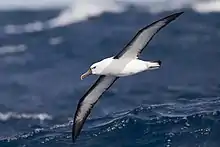
Order: Procellariiformes Family: Diomedeidae
The albatrosses are among the largest of flying birds, with those of the genus Diomedea having the largest wingspan of any extant bird.
| Common name | Binomial | Status |
|---|---|---|
| Yellow-nosed albatross | Thalassarche chlororhynchos | Endangered |
| Indian yellow-nosed albatross | Thalassarche carteri | Endangered |
| Grey-headed albatross | Thalassarche chrysostoma | Vagrant; endangered |
| Buller's albatross | Thalassarche bulleri | Vagrant; near threatened |
| White-capped albatross | Thalassarche cauta | Near threatened |
| Salvin's albatross | Thalassarche salvini | Vagrant; vulnerable |
| Chatham albatross | Thalassarche eremita | Vagrant; vulnerable |
| Black-browed albatross | Thalassarche melanophrys | |
| Sooty albatross | Phoebetria fusca | Vagrant; endangered |
| Light-mantled albatross | Phoebetria palpebrata | Vagrant; near threatened |
| Royal albatross | Diomedea epomophora | Vagrant; vulnerable |
| Wandering albatross | Diomedea exulans | Vulnerable |
| Laysan albatross | Phoebastria immutabilis | Vagrant; near threatened |
Southern storm-petrels

Order: Procellariiformes Family: Oceanitidae
The storm-petrels are the smallest seabirds, relatives of the petrels, feeding on planktonic crustaceans and small fish picked from the surface, typically while hovering. The flight is fluttering and sometimes bat-like. Until 2018, this family's species were included with the other storm-petrels in family Hydrobatidae.
| Common name | Binomial | Status |
|---|---|---|
| Wilson's storm-petrel | Oceanites oceanicus | |
| Grey-backed storm-petrel | Garrodia nereis | Vagrant |
| White-faced storm-petrel | Pelagodroma marina | Vagrant |
Northern storm-petrels
Order: Procellariiformes Family: Hydrobatidae
Though the members of this family are similar in many respects to the southern storm-petrels, including their general appearance and habits, there are enough genetic differences to warrant their placement in a separate family.
| Common name | Binomial | Status |
|---|---|---|
| European storm-petrel | Hydrobates pelagicus | |
| White-bellied storm-petrel | Fregetta grallaria | Vagrant |
| Black-bellied storm-petrel | Fregetta tropica | |
| Leach's storm-petrel | Oceanodroma leucorhoa | Vulnerable |
| Matsudaira's storm-petrel | Oceanodroma matsudairae | Vagrant; vulnerable |
Shearwaters and petrels
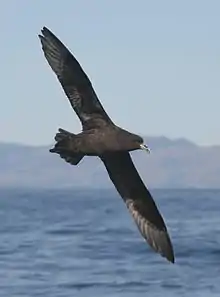
Order: Procellariiformes Family: Procellariidae
The procellariids are the main group of medium-sized "true petrels", characterised by united nostrils with medium septum and a long outer functional primary.
| Common name | Binomial | Status |
|---|---|---|
| Southern giant-petrel | Macronectes giganteus | |
| Northern giant-petrel | Macronectes halli | |
| Southern fulmar | Fulmarus glacialoides | |
| Antarctic petrel | Thalassoica antarctica | Vagrant |
| Cape petrel | Daption capense | |
| Kerguelen petrel | Aphrodroma brevirostris | Vagrant |
| Great-winged petrel | Pterodroma macroptera | |
| Soft-plumaged petrel | Pterodroma mollis | |
| Barau's petrel | Pterodroma baraui | Vagrant; endangered |
| White-headed petrel | Pterodroma lessonii | Vagrant |
| Atlantic petrel | Pterodroma incerta | Vagrant; endangered |
| Blue petrel | Halobaena caerulea | Vagrant |
| Fairy prion | Pachyptila turtur | Vagrant |
| Broad-billed prion | Pachyptila vittata | Vagrant |
| Salvin's prion | Pachyptila salvini | Vagrant |
| Antarctic prion | Pachyptila desolata | |
| Slender-billed prion | Pachyptila belcheri | Vagrant |
| Tahiti petrel | Pseudobulweria rostrata | Vagrant |
| Grey petrel | Procellaria cinerea | Vagrant; near threatened |
| White-chinned petrel | Procellaria aequinoctialis | Vulnerable |
| Spectacled petrel | Procellaria conspicillata | Vulnerable |
| Streaked shearwater | Calonectris leucomelas | Vagrant; near threatened |
| Cory's shearwater | Calonectris diomedea | |
| Flesh-footed shearwater | Ardenna carneipes | Near threatened |
| Great shearwater | Ardenna gravis | |
| Wedge-tailed shearwater | Ardenna pacifica | Vagrant |
| Sooty shearwater | Ardenna grisea | Near threatened |
| Manx shearwater | Puffinus puffinus | |
| Subantarctic shearwater | Puffinus elegans | Vagrant |
| Tropical shearwater | Puffinus bailloni | Vagrant |
Storks
Order: Ciconiiformes Family: Ciconiidae
Storks are large, long-legged, long-necked wading birds with long stout bills. Storks are mute, but bill-clattering is an important mode of communication at the nest. Their nests can be large and may be reused for many years. Many species are migratory.
| Common name | Binomial | Status |
|---|---|---|
| African openbill | Anastomus lamelligerus | |
| Black stork | Ciconia nigra | |
| Abdim's stork | Ciconia abdimii | |
| Woolly-necked stork | Ciconia episcopus | Vulnerable |
| White stork | Ciconia ciconia | |
| Saddle-billed stork | Ephippiorhynchus senegalensis | |
| Marabou stork | Leptoptilos crumenifer | |
| Yellow-billed stork | Mycteria ibis |
Frigatebirds
Order: Suliformes Family: Fregatidae
Frigatebirds are large seabirds usually found over tropical oceans. They are large, black, or black-and-white, with long wings and deeply forked tails. The males have coloured inflatable throat pouches. They do not swim or walk and cannot take off from a flat surface. Having the largest wingspan-to-body-weight ratio of any bird, they are essentially aerial, able to stay aloft for more than a week.
| Common name | Binomial | Status |
|---|---|---|
| Lesser frigatebird | Fregata ariel | Vagrant |
| Great frigatebird | Fregata minor | Vagrant |
Boobies and gannets

Order: Suliformes Family: Sulidae
The sulids comprise the gannets and boobies. Both groups are medium to large coastal seabirds that plunge-dive for fish.
| Common name | Binomial | Status |
|---|---|---|
| Masked booby | Sula dactylatra | Vagrant |
| Brown booby | Sula leucogaster | Vagrant |
| Red-footed booby | Sula sula | Vagrant |
| Cape gannet | Morus capensis | Endangered |
| Australasian gannet | Morus serrator | Vagrant |
Anhingas
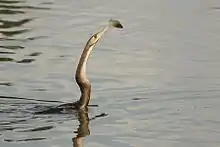
Order: Suliformes Family: Anhingidae
Anhingas or darters are often called "snake-birds" because of their long thin neck, which gives a snake-like appearance when they swim with their bodies submerged. The males have black and dark-brown plumage, an erectile crest on the nape, and a larger bill than the female. The females have much paler plumage especially on the neck and underparts. The darters have completely webbed feet and their legs are short and set far back on the body. Their plumage is somewhat permeable, like that of cormorants, and they spread their wings to dry after diving.
| Common name | Binomial | Status |
|---|---|---|
| African darter | Anhinga rufa |
Cormorants and shags
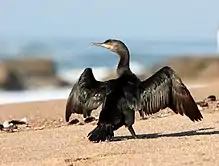
Order: Suliformes Family: Phalacrocoracidae
Phalacrocoracidae is a family of medium to large coastal, fish-eating seabirds that includes cormorants and shags. Plumage colouration varies, with the majority having mainly dark plumage, some species being black-and-white, and a few being colourful.
| Common name | Binomial | Status |
|---|---|---|
| Long-tailed cormorant | Microcarbo africanus | |
| Crowned cormorant | Microcarbo coronatus | Near threatened |
| Great cormorant | Phalacrocorax carbo | |
| Cape cormorant | Phalacrocorax capensis | Endangered |
| Bank cormorant | Phalacrocorax neglectus | Endangered |
Pelicans
Order: Pelecaniformes Family: Pelecanidae
Pelicans are large water birds with a distinctive pouch under their beak. As with other members of the order Pelecaniformes, they have webbed feet with four toes.
| Common name | Binomial | Status |
|---|---|---|
| Great white pelican | Pelecanus onocrotalus | |
| Pink-backed pelican | Pelecanus rufescens |
Hamerkop
Order: Pelecaniformes Family: Scopidae
The hamerkop is a medium-sized bird with a long shaggy crest. The shape of its head with a curved bill and crest at the back is reminiscent of a hammer, hence its name. Its plumage is drab-brown all over.
| Common name | Binomial | Status |
|---|---|---|
| Hamerkop | Scopus umbretta |
Herons, egrets, and bitterns

Order: Pelecaniformes Family: Ardeidae
The family Ardeidae contains the bitterns, herons, and egrets. Herons and egrets are medium to large wading birds with long necks and legs. Bitterns tend to be shorter necked and more wary. Members of Ardeidae fly with their necks retracted, unlike other long-necked birds such as storks, ibises, and spoonbills.
| Common name | Binomial | Status |
|---|---|---|
| Great bittern | Botaurus stellaris | |
| Little bittern | Ixobrychus minutus | |
| Dwarf bittern | Ixobrychus sturmii | |
| Grey heron | Ardea cinerea | |
| Black-headed heron | Ardea melanocephala | |
| Goliath heron | Ardea goliath | |
| Purple heron | Ardea purpurea | |
| Great egret | Ardea alba | |
| Intermediate egret | Ardea intermedia | |
| Madagascar pond-heron | Ardeola idae | Vagrant |
| Little egret | Egretta garzetta | |
| Snowy egret | Egretta thula | Vagrant |
| Little blue heron | Egretta caerulea | Vagrant |
| Slaty egret | Egretta vinaceigula | Vagrant; vulnerable |
| Black heron | Egretta ardesiaca | |
| Cattle egret | Bubulcus ibis | |
| Squacco heron | Ardeola ralloides | |
| Rufous-bellied heron | Ardeola rufiventris | |
| Striated heron | Butorides striata | |
| Black-crowned night-heron | Nycticorax nycticorax | |
| White-backed night-heron | Gorsachius leuconotus |
Ibises and spoonbills

Order: Pelecaniformes Family: Threskiornithidae
Threskiornithidae is a family of large terrestrial and wading birds which includes the ibises and spoonbills. They have long, broad wings with 11 primary and about 20 secondary feathers. They are strong fliers and despite their size and weight, very capable soarers.
| Common name | Binomial | Status |
|---|---|---|
| Glossy ibis | Plegadis falcinellus | |
| African sacred ibis | Threskiornis aethiopicus | |
| Southern bald ibis | Geronticus calvus | SLE endemic (see note);[notes 4] vulnerable |
| Hadada ibis | Bostrychia hagedash | |
| African spoonbill | Platalea alba |
Secretarybird
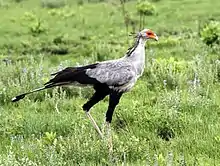
Order: Accipitriformes Family: Sagittariidae
The secretarybird is a bird of prey easily distinguished from other raptors by its long crane-like legs.
| Common name | Binomial | Status |
|---|---|---|
| Secretarybird | Sagittarius serpentarius | Vulnerable |
Osprey
Order: Accipitriformes Family: Pandionidae
The family Pandionidae contains only one species, the osprey. The osprey is a medium-large raptor which is a specialist fish-eater with a worldwide distribution.
| Common name | Binomial | Status |
|---|---|---|
| Osprey | Pandion haliaetus |
Hawks, eagles, and kites

Order: Accipitriformes Family: Accipitridae
Accipitridae is a family of birds of prey, which includes hawks, eagles, kites, harriers, and Old World vultures. These birds have powerful hooked beaks for tearing flesh from their prey, strong legs, powerful talons, and keen eyesight.
| Common name | Binomial | Status |
|---|---|---|
| Black-winged kite | Elanus caeruleus | |
| African harrier-hawk | Polyboroides typus | |
| Palm-nut vulture | Gypohierax angolensis | |
| Bearded vulture | Gypaetus barbatus | Near threatened |
| Egyptian vulture | Neophron percnopterus | Vagrant; endangered |
| European honey-buzzard | Pernis apivorus | |
| African cuckoo-hawk | Aviceda cuculoides | |
| White-headed vulture | Trigonoceps occipitalis | Critically endangered |
| Lappet-faced vulture | Torgos tracheliotos | Endangered |
| Hooded vulture | Necrosyrtes monachus | Critically endangered |
| White-backed vulture | Gyps africanus | Critically endangered |
| Rüppell's griffon | Gyps rueppelli | Vagrant; critically endangered |
| Cape griffon | Gyps coprotheres | Endangered |
| Bateleur | Terathopius ecaudatus | Near threatened |
| Black-chested snake-eagle | Circaetus pectoralis | |
| Brown snake-eagle | Circaetus cinereus | |
| Fasciated snake-eagle | Circaetus fasciolatus | Near threatened |
| Bat hawk | Macheiramphus alcinus | |
| Crowned eagle | Stephanoaetus coronatus | Near threatened |
| Martial eagle | Polemaetus bellicosus | Vulnerable |
| Long-crested eagle | Lophaetus occipitalis | |
| Lesser spotted eagle | Clanga pomarina | |
| Wahlberg's eagle | Hieraaetus wahlbergi | |
| Booted eagle | Hieraaetus pennatus | |
| Ayres's hawk-eagle | Hieraaetus ayresii | |
| Tawny eagle | Aquila rapax | |
| Steppe eagle | Aquila nipalensis | Endangered |
| Verreaux's eagle | Aquila verreauxii | |
| African hawk-eagle | Aquila spilogaster | |
| Lizard buzzard | Kaupifalco monogrammicus | |
| Dark chanting-goshawk | Melierax metabates | |
| Pale chanting-goshawk | Melierax canorus | |
| Gabar goshawk | Micronisus gabar | |
| Eurasian marsh-harrier | Circus aeruginosus | |
| African marsh-harrier | Circus ranivorus | |
| Black harrier | Circus maurus | Endangered |
| Pallid harrier | Circus macrourus | Near threatened |
| Montagu's harrier | Circus pygargus | |
| African goshawk | Accipiter tachiro | |
| Shikra | Accipiter badius | |
| Little sparrowhawk | Accipiter minullus | |
| Ovambo sparrowhawk | Accipiter ovampensis | |
| Rufous-breasted sparrowhawk | Accipiter rufiventris | |
| Black goshawk | Accipiter melanoleucus | |
| Black kite | Milvus migrans | |
| Yellow-billed kite | Milvus aegyptius | See notes below[notes 5][notes 6] |
| African fish-eagle | Haliaeetus vocifer | |
| Common buzzard | Buteo buteo | |
| Forest buzzard | Buteo trizonatus | SLE endemic (see note);[notes 7] near threatened |
| Red-necked buzzard | Buteo auguralis | Vagrant |
| Jackal buzzard | Buteo rufofuscus |
Barn-owls
Order: Strigiformes Family: Tytonidae
Barn-owls are medium to large owls with large heads and characteristic heart-shaped faces. They have long strong legs with powerful talons.
| Common name | Binomial | Status |
|---|---|---|
| African grass-owl | Tyto capensis | |
| Barn owl | Tyto alba |
Owls
Order: Strigiformes Family: Strigidae
The typical owls are small to large solitary nocturnal birds of prey. They have large forward-facing eyes and ears, a hawk-like beak, and a conspicuous circle of feathers around each eye called a facial disk.
| Common name | Binomial | Status |
|---|---|---|
| African scops-owl | Otus senegalensis | |
| Southern white-faced owl | Ptilopsis granti | |
| Cape eagle-owl | Bubo capensis | |
| Spotted eagle-owl | Bubo africanus | |
| Verreaux's eagle-owl | Bubo lacteus | |
| Pel's fishing-owl | Scotopelia peli | |
| Pearl-spotted owlet | Glaucidium perlatum | |
| African barred owlet | Glaucidium capense | |
| African wood-owl | Strix woodfordii | |
| Marsh owl | Asio capensis |
Mousebirds
Order: Coliiformes Family: Coliidae
The mousebirds are slender greyish or brown birds with soft, hairlike body feathers and very long thin tails. They are arboreal and scurry through the leaves like rodents in search of berries, fruit, and buds. They are acrobatic and can feed upside down. All species have strong claws and reversible outer toes. They also have crests and stubby bills.
| Common name | Binomial | Status |
|---|---|---|
| Speckled mousebird | Colius striatus | |
| White-backed mousebird | Colius colius | |
| Red-faced mousebird | Urocolius indicus |
Trogons
Order: Trogoniformes Family: Trogonidae
The family Trogonidae includes trogons and quetzals. Found in tropical woodlands worldwide, they feed on insects and fruit, and their broad bills and weak legs reflect their diet and arboreal habits. Although their flight is fast, they are reluctant to fly any distance. Trogons have soft, often colourful, feathers with distinctive male and female plumage.
| Common name | Binomial | Status |
|---|---|---|
| Narina trogon | Apaloderma narina |
Hoopoes
Order: Bucerotiformes Family: Upupidae
Hoopoes have black, white, and orangey-pink colouring with a large erectile crest on their head.
| Common name | Binomial | Status |
|---|---|---|
| Eurasian hoopoe | Upupa epops |
Woodhoopoes and scimitarbills
Order: Bucerotiformes Family: Phoeniculidae
The woodhoopoes are related to the hoopoes, hornbills, and ground-hornbills. They most resemble the hoopoes with their long curved bills, used to probe for insects, and short rounded wings. However, they differ in that they have metallic plumage, often blue, green, or purple, and lack an erectile crest.
| Common name | Binomial | Status |
|---|---|---|
| Green woodhoopoe | Phoeniculus purpureus | |
| Common scimitarbill | Rhinopomastus cyanomelas |
Ground-hornbills
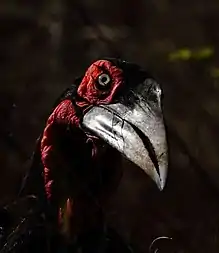
Order: Bucerotiformes Family: Bucorvidae
The ground-hornbills are terrestrial birds which feed almost entirely on insects, other birds, snakes, and amphibians.
| Common name | Binomial | Status |
|---|---|---|
| Southern ground-hornbill | Bucorvus leadbeateri | Vulnerable |
Hornbills
Order: Bucerotiformes Family: Bucerotidae
Hornbills are a group of birds whose bill is shaped like a cow's horn, but without a twist, sometimes with a casque on the upper mandible. Frequently, the bill is brightly coloured.
| Common name | Binomial | Status |
|---|---|---|
| Crowned hornbill | Lophoceros alboterminatus | |
| African grey hornbill | Lophoceros nasutus | |
| Southern yellow-billed hornbill | Tockus leucomelas | |
| Southern red-billed hornbill | Tockus rufirostris | |
| Trumpeter hornbill | Bycanistes bucinator |
Kingfishers
Order: Coraciiformes Family: Alcedinidae
Kingfishers are medium-sized birds with large heads, long pointed bills, short legs, and stubby tails.
| Common name | Binomial | Status |
|---|---|---|
| Half-collared kingfisher | Alcedo semitorquata | |
| Malachite kingfisher | Corythornis cristatus | |
| African pygmy-kingfisher | Ispidina picta | |
| Grey-headed kingfisher | Halcyon leucocephala | |
| Woodland kingfisher | Halcyon senegalensis | |
| Mangrove kingfisher | Halcyon senegaloides | |
| Brown-hooded kingfisher | Halcyon albiventris | |
| Striped kingfisher | Halcyon chelicuti | |
| Giant kingfisher | Megaceryle maxima | |
| Pied kingfisher | Ceryle rudis |
Bee-eaters
Order: Coraciiformes Family: Meropidae
The bee-eaters are a group of near passerine birds in the family Meropidae. Most species are found in Africa but others occur in southern Europe, Madagascar, Australia, and New Guinea. They are characterised by richly coloured plumage, slender bodies, and usually elongated central tail feathers. All are colourful and have long downturned bills and pointed wings, which give them a swallow-like appearance when seen from afar.
| Common name | Binomial | Status |
|---|---|---|
| White-fronted bee-eater | Merops bullockoides | |
| Little bee-eater | Merops pusillus | |
| Swallow-tailed bee-eater | Merops hirundineus | |
| White-throated bee-eater | Merops albicollis | Vagrant |
| Blue-cheeked bee-eater | Merops persicus | |
| Madagascar bee-eater | Merops superciliosus | Vagrant |
| European bee-eater | Merops apiaster | |
| Southern carmine bee-eater | Merops nubicoides |
Rollers
Order: Coraciiformes Family: Coraciidae
Rollers resemble crows in size and build, but are more closely related to the kingfishers and bee-eaters. They share the colourful appearance of those groups with blues and browns predominating. The two inner front toes are connected, but the outer toe is not.
| Common name | Binomial | Status |
|---|---|---|
| European roller | Coracias garrulus | |
| Lilac-breasted roller | Coracias caudatus | |
| Racket-tailed roller | Coracias spatulatus | |
| Rufous-crowned roller | Coracias naevius | |
| Broad-billed roller | Eurystomus glaucurus |
African barbets
Order: Piciformes Family: Lybiidae
The barbets are plump birds, with short necks and large heads. They get their name from the bristles which fringe their heavy bills. Most species are brightly coloured.
| Common name | Binomial | Status |
|---|---|---|
| Crested barbet | Trachyphonus vaillantii | |
| White-eared barbet | Stactolaema leucotis | |
| Green barbet | Stactolaema olivacea | |
| Yellow-rumped tinkerbird | Pogoniulus bilineatus | |
| Red-fronted tinkerbird | Pogoniulus pusillus | |
| Yellow-fronted tinkerbird | Pogoniulus chrysoconus | |
| Pied barbet | Tricholaema leucomelas | |
| Black-collared barbet | Lybius torquatus |
Honeyguides
Order: Piciformes Family: Indicatoridae
Honeyguides are among the few birds that feed on wax. They are named for the greater honeyguide which leads traditional honey-hunters to bees' nests and, after the hunters have harvested the honey, feeds on the remaining contents of the hive.
| Common name | Binomial | Status |
|---|---|---|
| Wahlberg's honeyguide | Prodotiscus regulus | |
| Lesser honeyguide | Indicator minor | |
| Scaly-throated honeyguide | Indicator variegatus | |
| Greater honeyguide | Indicator indicator |
Woodpeckers
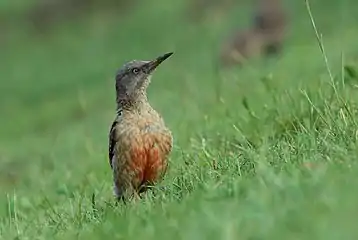
Order: Piciformes Family: Picidae
Woodpeckers are small to medium-sized birds with chisel-like beaks, short legs, stiff tails, and long tongues used for capturing insects. Some species have feet with two toes pointing forward and two backward, while several species have only three toes. Many woodpeckers have the habit of tapping noisily on tree trunks with their beaks.
| Common name | Binomial | Status |
|---|---|---|
| Rufous-necked wryneck | Jynx ruficollis | |
| Cardinal woodpecker | Chloropicus fuscescens | |
| Bearded woodpecker | Chloropicus namaquus | |
| Olive woodpecker | Chloropicus griseocephalus | |
| Ground woodpecker | Geocolaptes olivaceus | SLE endemic; near-threatened |
| Bennett's woodpecker | Campethera bennettii | |
| Golden-tailed woodpecker | Campethera abingoni | |
| Knysna woodpecker | Campethera notata | (see note);[notes 8] near threatened |
Falcons and caracaras
Order: Falconiformes Family: Falconidae
Falconidae is a family of diurnal birds of prey. They differ from hawks, eagles, and kites in that they kill with their beaks instead of their talons.
| Common name | Binomial | Status |
|---|---|---|
| Pygmy falcon | Polihierax semitorquatus | |
| Lesser kestrel | Falco naumanni | Vulnerable |
| Rock kestrel | Falco rupicolus | |
| Greater kestrel | Falco rupicoloides | |
| Dickinson's kestrel | Falco dickinsoni | |
| Red-necked falcon | Falco chicquera | |
| Red-footed falcon | Falco vespertinus | Near threatened ; winter migrant |
| Amur falcon | Falco amurensis | winter migrant |
| Eleonora's falcon | Falco eleonorae | Vagrant |
| Sooty falcon | Falco concolor | Near threatened |
| Eurasian hobby | Falco subbuteo | |
| African hobby | Falco cuvierii | Vagrant |
| Lanner falcon | Falco biarmicus | |
| Peregrine falcon | Falco peregrinus | |
| Taita falcon | Falco fasciinucha | Vulnerable |
Old World parrots
Order: Psittaciformes Family: Psittaculidae
Characteristic features of parrots include a strong curved bill, an upright stance, strong legs, and clawed zygodactyl feet. Many parrots are vividly coloured, and some are multi-coloured. In size they range from 8 cm (3.1 in) to 1 m (3.3 ft) in length. Old World parrots are found from Africa east across south and southeast Asia and Oceania to Australia and New Zealand.
| Common name | Binomial | Status |
|---|---|---|
| Rose-ringed parakeet | Psittacula krameri | Introduced |
| Rosy-faced lovebird | Agapornis roseicollis |
African and New World parrots
Order: Psittaciformes Family: Psittacidae
Parrots are small to large birds with a characteristic curved beak. Their upper mandibles have slight mobility in the joint with the skull and they have a generally erect stance. All parrots are zygodactyl, having the four toes on each foot placed two at the front and two to the back. Most of the more than 150 species in this family are found in the New World.
| Common name | Binomial | Status |
|---|---|---|
| Brown-necked parrot | Poicephalus fuscicollis | Vulnerable |
| Cape parrot | Poicephalus robustus | Endemic |
| Meyer's parrot | Poicephalus meyeri | |
| Brown-headed parrot | Poicephalus cryptoxanthus |
African and green broadbills
Order: Passeriformes Family: Calyptomenidae
The broadbills are small, brightly coloured birds which feed on fruit and also take insects in flycatcher fashion, snapping their broad bills. Their habitat is canopies of wet forests.
| Common name | Binomial | Status |
|---|---|---|
| African broadbill | Smithornis capensis |
Pittas
Order: Passeriformes Family: Pittidae
Pittas are medium-sized by passerine standards and are stocky, with fairly long, strong legs, short tails, and stout bills. Many are brightly coloured. They spend the majority of their time on wet forest floors, eating snails, insects, and similar invertebrates.
| Common name | Binomial | Status |
|---|---|---|
| African pitta | Pitta angolensis | Vagrant |
Cuckooshrikes
Order: Passeriformes Family: Campephagidae
The cuckooshrikes are small to medium-sized passerine birds. They are predominantly greyish with white and black, although some species are brightly coloured.
| Common name | Binomial | Status |
|---|---|---|
| Grey cuckooshrike | Coracina caesia | |
| White-breasted cuckooshrike | Coracina pectoralis | |
| Black cuckooshrike | Campephaga flava |
Old world orioles
.jpg.webp)
Order: Passeriformes Family: Oriolidae
The Old World orioles are colourful passerine birds. They are not related to the New World orioles though they appear similar.
| Common name | Binomial | Status |
|---|---|---|
| Eurasian golden oriole | Oriolus oriolus | |
| African golden oriole | Oriolus auratus | |
| African black-headed oriole | Oriolus larvatus |
Wattle-eyes and batises
Order: Passeriformes Family: Platysteiridae
The wattle-eyes, or puffback flycatchers, are small stout passerine birds of the African tropics. They get their name from the brightly coloured fleshy eye decorations found in most species in this group.
| Common name | Binomial | Status |
|---|---|---|
| Black-throated wattle-eye | Platysteira peltata | |
| Cape batis | Batis capensis | |
| Woodward's batis | Batis fratrum | |
| Chinspot batis | Batis molitor | |
| Pririt batis | Batis pririt |
Vangas, helmetshrikes, and allies
Order: Passeriformes Family: Vangidae
The helmetshrikes are similar in build to the shrikes, but tend to be colourful species with distinctive crests or other head ornaments, such as wattles, from which they get their name.
| Common name | Binomial | Status |
|---|---|---|
| White helmetshrike | Prionops plumatus | |
| Retz's helmetshrike | Prionops retzii | |
| Chestnut-fronted helmetshrike | Prionops scopifrons | Vagrant |
Bushshrikes and allies
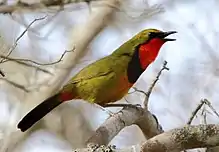
Order: Passeriformes Family: Malaconotidae
Bushshrikes are similar in habits to shrikes, hunting insects and other small prey from a perch on a bush. Although similar in build to the shrikes, these tend to be either colourful species or largely black; some species are quite secretive.
| Common name | Binomial | Status |
|---|---|---|
| Brubru | Nilaus afer | |
| Black-backed puffback | Dryoscopus cubla | |
| Black-crowned tchagra | Tchagra senegalus | |
| Brown-crowned tchagra | Tchagra australis | |
| Southern tchagra | Tchagra tchagra | |
| Tropical boubou | Laniarius major | |
| Southern boubou | Laniarius ferrugineus | |
| Crimson-breasted gonolek | Laniarius atrococcineus | |
| Bokmakierie | Telophorus zeylonus | |
| Sulphur-breasted bushshrike | Telophorus sulfureopectus | |
| Olive bushshrike | Telophorus olivaceus | |
| Black-fronted bushshrike | Telophorus nigrifrons | |
| Four-coloured bushshrike | Telophorus viridis | |
| Grey-headed bushshrike | Malaconotus blanchoti |
Drongos
Order: Passeriformes Family: Dicruridae
The drongos are mostly black or dark grey in colour, sometimes with metallic tints. They have long forked tails, and some Asian species have elaborate tail decorations. They have short legs and sit very upright when perched, like a shrike. They flycatch or take prey from the ground.
| Common name | Binomial | Status |
|---|---|---|
| Common square-tailed drongo | Dicrurus ludwigii | |
| Fork-tailed drongo | Dicrurus adsimilis |
Monarch flycatchers
Order: Passeriformes Family: Monarchidae
The monarch flycatchers are small to medium-sized insectivorous passerines which hunt by flycatching.
| Common name | Binomial | Status |
|---|---|---|
| African crested-flycatcher | Trochocercus cyanomelas | |
| African paradise-flycatcher | Terpsiphone viridis |
Shrikes
Order: Passeriformes Family: Laniidae
Shrikes are passerine birds known for their habit of catching other birds and small animals and impaling the uneaten portions of their bodies on thorns. A shrike's beak is hooked, like that of a typical bird of prey.
| Common name | Binomial | Status |
|---|---|---|
| Red-backed shrike | Lanius collurio | |
| Lesser grey shrike | Lanius minor | winter migrant |
| Southern fiscal | Lanius collaris | |
| Magpie shrike | Corvinella melanoleuca | |
| White-crowned shrike | Eurocephalus anguitimens |
Crows, jays, and magpies
Order: Passeriformes Family: Corvidae
The family Corvidae includes crows, ravens, jays, choughs, magpies, treepies, nutcrackers, and ground jays. Corvids are above average in size among the Passeriformes, and some of the larger species show high levels of intelligence.
| Common name | Binomial | Status |
|---|---|---|
| House crow | Corvus splendens | Introduced |
| Cape crow | Corvus capensis | |
| Pied crow | Corvus albus | |
| White-necked raven | Corvus albicollis |
Rockjumpers
Order: Passeriformes Family: Chaetopidae
These two species are the only ones in their family. They are primarily insectivores, but cape rockjumpers also eat small vertebrates.
| Common name | Binomial | Status |
|---|---|---|
| Cape rockjumper | Chaetops frenatus | Endemic; near-threatened |
| Drakensberg rockjumper | Chaetops aurantius | SLE endemic; near-threatened |
Hyliotas
Order: Passeriformes Family: Hyliotidae
The members of this small family, all of genus Hyliota, are birds of the forest canopy. They tend to feed in mixed-species flocks.
| Common name | Binomial | Status |
|---|---|---|
| Southern hyliota | Hyliota australis |
Fairy flycatchers
Order: Passeriformes Family: Stenostiridae
Most of the species of this small family are found in Africa, though a few inhabit tropical Asia. They are not closely related to other birds called "flycatchers".
| Common name | Binomial | Status |
|---|---|---|
| Fairy flycatcher | Stenostira scita |
Tits, chickadees, and titmice
Order: Passeriformes Family: Paridae
The Paridae are mainly small stocky woodland species with short stout bills. Some have crests. They are adaptable birds, with a mixed diet including seeds and insects.
| Common name | Binomial | Status |
|---|---|---|
| Southern black-tit | Melaniparus niger | |
| Ashy tit | Melaniparus cinerascens | |
| Grey tit | Melaniparus afer |
Penduline-tits
Order: Passeriformes Family: Remizidae
The penduline-tits are a group of small passerine birds related to the true tits. They are insectivores.
| Common name | Binomial | Status |
|---|---|---|
| African penduline-tit | Anthoscopus caroli | |
| Southern penduline-tit | Anthoscopus minutus |
Larks
.jpg.webp)
Order: Passeriformes Family: Alaudidae
Larks are small terrestrial birds with often extravagant songs and display flights. Most larks are fairly dull in appearance. Their food is insects and seeds.
| Common name | Binomial | Status |
|---|---|---|
| Spike-heeled lark | Chersomanes albofasciata | |
| Short-clawed lark | Certhilauda chuana | |
| Karoo long-billed lark | Certhilauda subcoronata | |
| Eastern long-billed lark | Certhilauda semitorquata | SLE endemic (see note)[notes 9] |
| Cape lark | Certhilauda curvirostris | Endemic (see note)[notes 10] |
| Agulhas lark | Certhilauda brevirostris | Endemic; near threatened |
| Dusky lark | Pinarocorys nigricans | |
| Black-eared sparrow-lark | Eremopterix australis | |
| Chestnut-backed sparrow-lark | Eremopterix leucotis | |
| Grey-backed sparrow-lark | Eremopterix verticalis | |
| Sabota lark | Calendulauda sabota | |
| Fawn-coloured lark | Calendulauda africanoides | |
| Red lark | Calendulauda burra | Endemic; vulnerable |
| Karoo lark | Calendulauda albescens | Endemic |
| Barlow's lark | Calendulauda barlowi | |
| Rudd's lark | Heteromirafra ruddi | Endemic; endangered |
| Cape clapper lark | Mirafra apiata | |
| Eastern clapper lark | Mirafra fasciolata | |
| Rufous-naped lark | Mirafra africana | |
| Flappet lark | Mirafra rufocinnamomea | |
| Monotonous lark | Mirafra passerina | |
| Latakoo lark | Mirafra cheniana | |
| Red-capped lark | Calandrella cinerea | |
| Stark's lark | Spizocorys starki | |
| Sclater's lark | Spizocorys sclateri | Near threatened |
| Pink-billed lark | Spizocorys conirostris | |
| Botha's lark | Spizocorys fringillaris | Endemic; endangered |
| Large-billed lark | Galerida magnirostris |
Nicators
Order: Passeriformes Family: Nicatoridae
The nicators are shrike-like, with hooked bills. They are endemic to sub-Saharan Africa.
| Common name | Binomial | Status |
|---|---|---|
| Eastern nicator | Nicator gularis |
African warblers

Order: Passeriformes Family: Macrosphenidae
African warblers are small to medium-sized insectivores which are found in a wide variety of habitats south of the Sahara.
| Common name | Binomial | Status |
|---|---|---|
| Cape crombec | Sylvietta rufescens | |
| Cape grassbird | Sphenoeacus afer | |
| Victorin's warbler | Cryptillas victorini | Endemic |
Cisticolas and allies

Order: Passeriformes Family: Cisticolidae
The Cisticolidae are warblers found mainly in warmer southern regions of the Old World. They are generally very small birds of drab brown or grey appearance found in open country such as grassland or scrub.
| Common name | Binomial | Status |
|---|---|---|
| Yellow-bellied eremomela | Eremomela icteropygialis | |
| Greencap eremomela | Eremomela scotops | |
| Yellow-rumped eremomela | Eremomela gregalis | |
| Burnt-neck eremomela | Eremomela usticollis | |
| Stierling's wren-warbler | Calamonastes stierlingi | |
| Barred wren-warbler | Calamonastes fasciolatus | |
| Green-backed camaroptera | Camaroptera brachyura | |
| Bar-throated apalis | Apalis thoracica | |
| Yellow-breasted apalis | Apalis flavida | |
| Rudd's apalis | Apalis ruddi | |
| Tawny-flanked prinia | Prinia subflava | |
| Black-chested prinia | Prinia flavicans | |
| Karoo prinia | Prinia maculosa | |
| Drakensberg prinia | Prinia hypoxantha | SLE endemic |
| Namaqua warbler | Prinia substriata | |
| Kopje warbler | Euryptila subcinnamomea | |
| Rufous-eared warbler | Malcorus pectoralis | |
| Red-faced cisticola | Cisticola erythrops | |
| Rock-loving cisticola | Cisticola aberrans | |
| Rattling cisticola | Cisticola chiniana | |
| Tinkling cisticola | Cisticola rufilatus | |
| Red-headed cisticola | Cisticola subruficapilla | |
| Wailing cisticola | Cisticola lais | |
| Rufous-winged cisticola | Cisticola galactotes | |
| Levaillant's cisticola | Cisticola tinniens | |
| Croaking cisticola | Cisticola natalensis | |
| Piping cisticola | Cisticola fulvicapilla | |
| Zitting cisticola | Cisticola juncidis | |
| Desert cisticola | Cisticola aridulus | |
| Cloud cisticola | Cisticola textrix | |
| Pale-crowned cisticola | Cisticola cinnamomeus | |
| Wing-snapping cisticola | Cisticola ayresii |
Reed warblers and allies
Order: Passeriformes Family: Acrocephalidae
The members of this family are usually rather large for "warblers". Most are rather plain olivaceous brown above with much yellow to beige below. They are usually found in open woodland, reedbeds, or tall grass. The family occurs mostly in southern to western Eurasia and surroundings, but it also ranges far into the Pacific, with some species in Africa.
| Common name | Binomial | Status |
|---|---|---|
| African yellow-warbler | Iduna natalensis | |
| Upcher's warbler | Hippolais languida | Vagrant |
| Olive-tree warbler | Hippolais olivetorum | winter migrant |
| Icterine warbler | Hippolais icterina | |
| Sedge warbler | Acrocephalus schoenobaenus | |
| Marsh warbler | Acrocephalus palustris | winter migrant |
| Eurasian reed warbler | Acrocephalus scirpaceus | |
| African reed warbler | Acrocephalus baeticatus | |
| Basra reed warbler | Acrocephalus griseldis | Vagrant |
| Lesser swamp warbler | Acrocephalus gracilirostris | |
| Great reed warbler | Acrocephalus arundinaceus |
Grassbirds and allies
Order: Passeriformes Family: Locustellidae
Locustellidae are a family of small insectivorous songbirds found mainly in Eurasia, Africa, and the Australian region. They are smallish birds with tails that are usually long and pointed, and tend to be drab brownish or buffy all over.
| Common name | Binomial | Status |
|---|---|---|
| Fan-tailed grassbird | Schoenicola brevirostris | |
| Barratt's warbler | Bradypterus barratti | |
| Knysna warbler | Bradypterus sylvaticus | Endemic; vulnerable |
| Little rush-warbler | Bradypterus baboecala | |
| River warbler | Locustella fluviatilis |
Swallows
.jpg.webp)
Order: Passeriformes Family: Hirundinidae
The family Hirundinidae is adapted to aerial feeding. They have a slender streamlined body, long pointed wings, and a short bill with a wide gape. The feet are adapted to perching rather than walking, and the front toes are partially joined at the base.
| Common name | Binomial | Status |
|---|---|---|
| Plain martin | Riparia paludicola | |
| Bank swallow | Riparia riparia | |
| Banded martin | Riparia cincta | |
| Rock martin | Ptyonoprogne fuligula | |
| Barn swallow | Hirundo rustica | |
| White-throated swallow | Hirundo albigularis | |
| Wire-tailed swallow | Hirundo smithii | |
| Pearl-breasted swallow | Hirundo dimidiata | |
| Montane blue swallow | Hirundo atrocaerulea | Vulnerable |
| Greater striped swallow | Cecropis cucullata | |
| Lesser striped swallow | Cecropis abyssinica | |
| Rufous-chested swallow | Cecropis semirufa | |
| Mosque swallow | Cecropis senegalensis | |
| South African swallow | Petrochelidon spilodera | |
| Common house-martin | Delichon urbicum | |
| Black sawwing | Psalidoprocne pristoptera | |
| Grey-rumped swallow | Pseudhirundo griseopyga |
Bulbuls
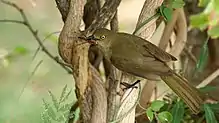
Order: Passeriformes Family: Pycnonotidae
Bulbuls are medium-sized songbirds. Some are colourful with yellow, red, or orange vents, cheeks, throats or supercilia, but most are drab, with uniform olive-brown to black plumage. Some species have distinct crests.
| Common name | Binomial | Status |
|---|---|---|
| Sombre greenbul | Andropadus importunus | |
| Yellow-bellied greenbul | Chlorocichla flaviventris | |
| Terrestrial brownbul | Phyllastrephus terrestris | |
| Yellow-streaked greenbul | Phyllastrephus flavostriatus | |
| Common bulbul | Pycnonotus barbatus | |
| Black-fronted bulbul | Pycnonotus nigricans | |
| Cape bulbul | Pycnonotus capensis | Endemic |
Leaf warblers
Order: Passeriformes Family: Phylloscopidae
Leaf warblers are a family of small insectivorous birds found mostly in Eurasia and ranging into Wallacea and Africa. The species are of various sizes, often green-plumaged above and yellow below, or more subdued with greyish-green to greyish-brown colours.
| Common name | Binomial | Status |
|---|---|---|
| Willow warbler | Phylloscopus trochilus | |
| Yellow-throated woodland-warbler | Phylloscopus ruficapillus |
Bush warblers and allies
Order: Passeriformes Family: Scotocercidae
The members of this family are found throughout Africa, Asia, and Polynesia. Their taxonomy is in flux, and some authorities place genus Erythrocerus in another family.[3]
| Common name | Binomial | Status |
|---|---|---|
| Livingstone's flycatcher | Erythrocercus livingstonei | Vagrant |
Sylviid warblers, parrotbills, and allies
Order: Passeriformes Family: Sylviidae
The family Sylviidae ("Old World warblers") is a group of small insectivorous passerine birds. They mainly occur as breeding species, as one common name implies, in Europe, Asia, and, to a lesser extent, Africa. Most are of generally undistinguished appearance, but many have distinctive songs.
| Common name | Binomial | Status |
|---|---|---|
| Bush blackcap | Sylvia nigricapillus | SLE endemic; vulnerable |
| Eurasian blackcap | Sylvia atricapilla | Vagrant |
| Garden warbler | Sylvia borin | |
| Layard's warbler | Sylvia layardi | |
| Chestnut-vented warbler | Sylvia subcoerulea | |
| Greater whitethroat | Sylvia communis |
White-eyes, yuhinas, and allies
Order: Passeriformes Family: Zosteropidae
The white-eyes are small and mostly undistinguished, their plumage above being generally some dull colour like greenish-olive, but some species have a white or bright yellow throat, breast, or lower parts, and several have buff flanks. As their name suggests, many species have a white ring around each eye.
| Common name | Binomial | Status |
|---|---|---|
| Orange River white-eye | Zosterops pallidus | |
| Cape white-eye | Zosterops virens | |
| African yellow white-eye | Zosterops senegalensis |
Laughingthrushes and allies
Order: Passeriformes Family: Leiothrichidae
The members of this family are diverse in size and colouration, though those of genus Turdoides tend to be brown or greyish. The family is found in Africa, India, and southeast Asia.
| Common name | Binomial | Status |
|---|---|---|
| Southern pied-babbler | Turdoides bicolor | |
| Arrow-marked babbler | Turdoides jardineii |
Treecreepers
Order: Passeriformes Family: Certhiidae
Treecreepers are small woodland birds, brown above and white below. They have thin pointed down-curved bills which they use to extricate insects from bark. They have stiff tail feathers, like woodpeckers, which they use to support themselves on vertical trees.
| Common name | Binomial | Status |
|---|---|---|
| African spotted creeper | Salpornis salvadori |
Oxpeckers
Order: Passeriformes Family: Buphagidae
As both the English and scientific names of these birds imply, they feed on ectoparasites, primarily ticks, found on large mammals.
| Common name | Binomial | Status |
|---|---|---|
| Red-billed oxpecker | Buphagus erythrorynchus | |
| Yellow-billed oxpecker | Buphagus africanus |
Starlings
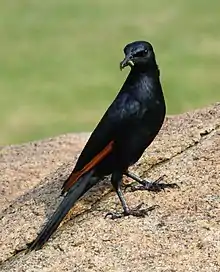
Order: Passeriformes Family: Sturnidae
Starlings are small to medium-sized passerine birds. Their flight is strong and direct and they are very gregarious. Their preferred habitat is fairly open country. They eat insects and fruit. Plumage is typically dark with a metallic sheen.
| Common name | Binomial | Status |
|---|---|---|
| European starling | Sturnus vulgaris | Introduced |
| Wattled starling | Creatophora cinerea | |
| Rosy starling | Pastor roseus | Vagrant |
| Common myna | Acridotheres tristis | Introduced |
| Violet-backed starling | Cinnyricinclus leucogaster | |
| Pale-winged starling | Onychognathus nabouroup | |
| Red-winged starling | Onychognathus morio | |
| Black-bellied starling | Notopholia corusca | |
| Burchell's glossy-starling | Lamprotornis australis | |
| Meves's glossy-starling | Lamprotornis mevesii | |
| African pied starling | Lamprotornis bicolor | SLE endemic (see note)[notes 11] |
| Lesser blue-eared starling | Lamprotornis chloropterus | Vagrant |
| Greater blue-eared starling | Lamprotornis chalybaeus | |
| Cape starling | Lamprotornis nitens |
Thrushes and allies
Order: Passeriformes Family: Turdidae
The thrushes are a group of passerine birds that occur mainly in the Old World. They are plump, soft plumaged, small to medium-sized insectivores or sometimes omnivores, often feeding on the ground. Many have attractive songs.
| Common name | Binomial | Status |
|---|---|---|
| Spotted ground-thrush | Geokichla guttata | Endangered |
| Orange ground-thrush | Geokichla gurneyi | |
| Groundscraper thrush | Psophocichla litsitsirupa | |
| Kurrichane thrush | Turdus libonyana | |
| Olive thrush | Turdus olivaceus | |
| Karoo thrush | Turdus smithi |
Old World flycatchers
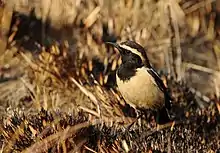
Order: Passeriformes Family: Muscicapidae
Old World flycatchers are a large group of small passerine birds native to the Old World. They are mainly small arboreal insectivores. The appearance of these birds is highly varied, but they mostly have weak songs and harsh calls.
| Common name | Binomial | Status |
|---|---|---|
| African dusky flycatcher | Muscicapa adusta | |
| Spotted flycatcher | Muscicapa striata | |
| Mariqua flycatcher | Bradornis mariquensis | |
| Pale flycatcher | Agricola pallidus | |
| Chat flycatcher | Agricola infuscatus | |
| Grey tit-flycatcher | Fraseria plumbea | |
| Ashy flycatcher | Fraseria caerulescens | |
| Fiscal flycatcher | Melaenornis silens | |
| Southern black-flycatcher | Melaenornis pammelaina | |
| Karoo scrub-robin | Cercotrichas coryphoeus | |
| Brown scrub-robin | Cercotrichas signata | |
| Bearded scrub-robin | Cercotrichas quadrivirgata | |
| Rufous-tailed scrub-robin | Cercotrichas galactotes | Vagrant |
| Kalahari scrub-robin | Cercotrichas paena | |
| Red-backed scrub-robin | Cercotrichas leucophrys | |
| Cape robin-chat | Cossypha caffra | |
| White-throated robin-chat | Cossypha humeralis | |
| White-browed robin-chat | Cossypha heuglini | |
| Red-capped robin-chat | Cossypha natalensis | |
| Chorister robin-chat | Cossypha dichroa | SLE endemic |
| Collared palm-thrush | Cichladusa arquata | |
| White-starred robin | Pogonocichla stellata | |
| White-throated robin | Irania gutturalis | Vagrant |
| Thrush nightingale | Luscinia luscinia | Vagrant |
| European pied flycatcher | Ficedula hypoleuca | Vagrant |
| Collared flycatcher | Ficedula albicollis | Vagrant |
| Common redstart | Phoenicurus phoenicurus | Vagrant |
| Short-toed rock-thrush | Monticola brevipes | |
| Sentinel rock-thrush | Monticola explorator | SLE endemic (see note);[notes 12] near-threatened |
| Cape rock-thrush | Monticola rupestris | SLE endemic (see note)[notes 13] |
| Whinchat | Saxicola rubetra | Vagrant |
| African stonechat | Saxicola torquatus | |
| Buff-streaked chat | Campicoloides bifasciatus | SLE endemic |
| Sickle-winged chat | Emarginata sinuata | |
| Karoo chat | Emarginata schlegelii | |
| Tractrac chat | Emarginata tractrac | |
| Mocking cliff-chat | Thamnolaea cinnamomeiventris | |
| Southern anteater-chat | Myrmecocichla formicivora | |
| Mountain wheatear | Myrmecocichla monticola | |
| Arnot's chat | Myrmecocichla arnotti | |
| Northern wheatear | Oenanthe oenanthe | Vagrant |
| Capped wheatear | Oenanthe pileata | |
| Pied wheatear | Oenanthe pleschanka | Vagrant |
| Familiar chat | Oenanthe familiaris | |
| Boulder chat | Pinarornis plumosus | Vagrant |
Sugarbirds
.jpg.webp)
Order: Passeriformes Family: Promeropidae
The two species in this family are restricted to southern Africa. They have brownish plumage, a long downcurved bill, and long tail feathers.
| Common name | Binomial | Status |
|---|---|---|
| Gurney's sugarbird | Promerops gurneyi | Near-threatened |
| Cape sugarbird | Promerops cafer | endemic |
Sunbirds and spiderhunters
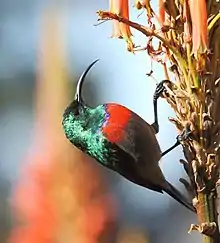
Order: Passeriformes Family: Nectariniidae
The sunbirds and spiderhunters are very small passerine birds which feed largely on nectar, although they will also take insects, especially when feeding young. Flight is fast and direct on their short wings. Most species can take nectar by hovering like a hummingbird, but usually perch to feed.
| Common name | Binomial | Status |
|---|---|---|
| Plain-backed sunbird | Anthreptes reichenowi | |
| Collared sunbird | Hedydipna collaris | |
| Orange-breasted sunbird | Anthobaphes violacea | Endemic |
| Olive sunbird | Cyanomitra olivacea | |
| Mouse-coloured sunbird | Cyanomitra veroxii | |
| Amethyst sunbird | Chalcomitra amethystina | |
| Scarlet-chested sunbird | Chalcomitra senegalensis | |
| Malachite sunbird | Nectarinia famosa | |
| Southern double-collared sunbird | Cinnyris chalybeus | |
| Neergaard's sunbird | Cinnyris neergaardi | Near threatened |
| Greater double-collared sunbird | Cinnyris afer | SLE endemic |
| Mariqua sunbird | Cinnyris mariquensis | |
| Purple-banded sunbird | Cinnyris bifasciatus | |
| White-breasted sunbird | Cinnyris talatala | |
| Variable sunbird | Cinnyris venustus | Vagrant |
| Dusky sunbird | Cinnyris fuscus |
Weavers and allies
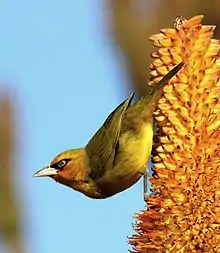
Order: Passeriformes Family: Ploceidae
The weavers are small passerine birds related to the finches. They are seed-eating birds with rounded conical bills. The males of many species are brightly coloured, usually in red or yellow and black. Some species show variation in colour only in the breeding season.
| Common name | Binomial | Status |
|---|---|---|
| Red-billed buffalo-weaver | Bubalornis niger | |
| Scaly weaver | Sporopipes squamifrons | |
| White-browed sparrow-weaver | Plocepasser mahali | |
| Sociable weaver | Philetairus socius | |
| Red-headed weaver | Anaplectes rubriceps | |
| Spectacled weaver | Ploceus ocularis | |
| Cape weaver | Ploceus capensis | Endemic |
| African golden-weaver | Ploceus subaureus | |
| Holub's golden-weaver | Ploceus xanthops | |
| Southern brown-throated weaver | Ploceus xanthopterus | |
| Lesser masked-weaver | Ploceus intermedius | |
| Southern masked-weaver | Ploceus velatus | |
| Village weaver | Ploceus cucullatus | |
| Chestnut weaver | Ploceus rubiginosus | Vagrant |
| Forest weaver | Ploceus bicolor | |
| Red-headed quelea | Quelea erythrops | |
| Red-billed quelea | Quelea quelea | |
| Southern red bishop | Euplectes orix | |
| Yellow-crowned bishop | Euplectes afer | |
| Yellow bishop | Euplectes capensis | |
| White-winged widowbird | Euplectes albonotatus | |
| Red-collared widowbird | Euplectes ardens | |
| Fan-tailed widowbird | Euplectes axillaris | |
| Long-tailed widowbird | Euplectes progne | |
| Grosbeak weaver | Amblyospiza albifrons |
Waxbills and allies
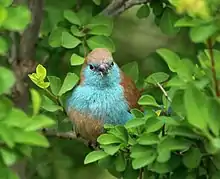
Order: Passeriformes Family: Estrildidae
The estrildid finches are small passerine birds of the Old World tropics and Australasia. They are gregarious and often colonial seed eaters with short thick but pointed bills. They are all similar in structure and habits, but have wide variation in plumage colours and patterns.
| Common name | Binomial | Status |
|---|---|---|
| Swee waxbill | Coccopygia melanotis | |
| Green-backed twinspot | Mandingoa nitidula | |
| Black-tailed waxbill | Estrilda perreini | |
| Common waxbill | Estrilda astrild | |
| Black-faced waxbill | Estrilda erythronotos | |
| Southern cordonbleu | Uraeginthus angolensis | |
| Violet-eared waxbill | Uraeginthus granatina | |
| Peters's twinspot | Hypargos niveoguttatus | |
| Pink-throated twinspot | Hypargos margaritatus | |
| Green-winged pytilia | Pytilia melba | |
| Orange-winged pytilia | Pytilia afra | |
| Red-billed firefinch | Lagonosticta senegala | |
| African firefinch | Lagonosticta rubricata | |
| Jameson's firefinch | Lagonosticta rhodopareia | |
| Cut-throat | Amadina fasciata | |
| Red-headed finch | Amadina erythrocephala | |
| Zebra waxbill | Sporaeginthus subflavus | |
| Quailfinch | Ortygospiza atricollis | |
| Bronze mannikin | Spermestes cucullata | |
| Black-and-white mannikin | Spermestes bicolor | (see note)[notes 14] |
| Magpie mannikin | Spermestes fringilloides |
Indigobirds
Order: Passeriformes Family: Viduidae
The indigobirds are finch-like species which usually have black or indigo predominating in their plumage. All are brood parasites which lay their eggs in the nests of estrildid finches.
| Common name | Binomial | Status |
|---|---|---|
| Pin-tailed whydah | Vidua macroura | |
| Broad-tailed paradise-whydah | Vidua obtusa | Vagrant |
| Eastern paradise-whydah | Vidua paradisaea | |
| Shaft-tailed whydah | Vidua regia | |
| Village indigobird | Vidua chalybeata | |
| Variable indigobird | Vidua funerea | |
| Purple indigobird | Vidua purpurascens | |
| Parasitic weaver | Anomalospiza imberbis |
Old World sparrows
Order: Passeriformes Family: Passeridae
Sparrows are small passerine birds. In general, sparrows tend to be small, plump, brown, or grey birds with short tails and short powerful beaks. Sparrows are seed eaters, but they also consume small insects.
| Common name | Binomial | Status |
|---|---|---|
| House sparrow | Passer domesticus | Introduced |
| Great rufous sparrow | Passer motitensis | |
| Cape sparrow | Passer melanurus | |
| Southern grey-headed sparrow | Passer diffusus | |
| Yellow-throated bush sparrow | Gymnoris superciliaris |
Wagtails and pipits
.jpg.webp)
Order: Passeriformes Family: Motacillidae
Motacillidae is a family of small passerine birds with medium to long tails. They are slender ground-feeding insectivores of open country.
| Common name | Binomial | Status |
|---|---|---|
| Cape wagtail | Motacilla capensis | |
| Mountain wagtail | Motacilla clara | |
| Grey wagtail | Motacilla cinerea | Vagrant |
| Western yellow wagtail | Motacilla flava | |
| Citrine wagtail | Motacilla citreola | Vagrant |
| African pied wagtail | Motacilla aguimp | |
| White wagtail | Motacilla alba | Vagrant |
| African pipit | Anthus cinnamomeus | |
| Mountain pipit | Anthus hoeschi | SLE endemic; near-threatened |
| Long-billed pipit | Anthus similis | |
| Plain-backed pipit | Anthus leucophrys | |
| Buffy pipit | Anthus vaalensis | |
| Striped pipit | Anthus lineiventris | |
| Yellow-tufted pipit | Anthus crenatus | SLE endemic |
| Tree pipit | Anthus trivialis | |
| Red-throated pipit | Anthus cervinus | Vagrant |
| Short-tailed pipit | Anthus brachyurus | |
| Bush pipit | Anthus caffer | |
| Golden pipit | Tmetothylacus tenellus | Vagrant |
| Yellow-breasted pipit | Hemimacronyx chloris | Endemic (see note),[notes 15] vulnerable |
| Orange-throated longclaw | Macronyx capensis | |
| Yellow-throated longclaw | Macronyx croceus | |
| Rosy-throated longclaw | Macronyx ameliae |
Finches, euphonias, and allies
Order: Passeriformes Family: Fringillidae
Finches are seed-eating passerine birds that are small to moderately large and have a strong beak, usually conical and in some species very large. All have twelve tail feathers and nine primaries. These birds have a bouncing flight with alternating bouts of flapping and gliding on closed wings, and most sing well.
| Common name | Binomial | Status |
|---|---|---|
| Common chaffinch | Fringilla coelebs | Introduced |
| Yellow-fronted canary | Crithagra mozambica | |
| Forest canary | Crithagra scotops | SLS endemic |
| Black-throated canary | Crithagra atrogularis | |
| Lemon-breasted seedeater | Crithagra citrinipectus | |
| Brimstone canary | Crithagra sulphurata | |
| Yellow canary | Crithagra flaviventris | |
| White-throated canary | Crithagra albogularis | |
| Protea canary | Crithagra leucoptera | Endemic; near-threatened |
| Streaky-headed seedeater | Crithagra gularis | |
| Cape siskin | Crithagra totta | Endemic |
| Drakensberg siskin | Crithagra symonsi | SLS endemic |
| Cape canary | Serinus canicollis | |
| Black-headed canary | Serinus alario |
Old World buntings
Order: Passeriformes Family: Emberizidae
The emberizids are a large family of passerine birds. They are seed-eating birds with distinctively shaped bills. In Europe, most species are called buntings. Many emberizid species have distinctive head patterns.
| Common name | Binomial | Status |
|---|---|---|
| Golden-breasted bunting | Emberiza flaviventris | |
| Cape bunting | Emberiza capensis | |
| Lark-like bunting | Emberiza impetuani | |
| Cinnamon-breasted bunting | Emberiza tahapisi |
Notes
- Clements lists this species as endemic
- Clements lists this species as endemic to South Africa alone
- Subspecies L. d. vetula is a resident breeder, sometimes called the Cape gull.
- Clements lists this species as endemic to South Africa alone
- Considered a subspecies of the preceding species by Clements; deemed a full species by BLSA
- Johnson JA, Richard T. Watson and David P. Mindell (2005). "Prioritizing species conservation: does the Cape Verde kite exist?" (PDF). Proc. R. Soc. B. 272 (1570): 1365–1371. doi:10.1098/rspb.2005.3098. PMC 1560339. PMID 16006325. Archived from the original (PDF) on 2010-12-19. Retrieved 2011-01-06. This mitochondrial study of Milvus kites, employing three genes, determined that the black kite (Milvus m. migrans) of the Eurasian clade differs significantly from the allopatric yellow-billed kite, where the latter could be further subdivided into two groups: those from southern Africa and Madagascar differing from those in central, west and east Africa. These taxa are all distinct, though near-related as in the Eurasian clade. The study revealed besides that the two yellow-billed kite taxa could potentially be assigned species status. In such a three-way split the yellow-billed kite of southern Africa would be named M. parasitus.
- Clements lists this species as endemic to South Africa alone
- Clements lists this species as endemic
- Clements lists this species as endemic to South Africa alone
- Clements lists this species as also inhabiting Namibia
- Clements lists this species as inhabiting several other countries as well
- Clements lists this species as also inhabiting Mozambique
- Clements lists this species as also inhabiting Botswana and Mozambique
- BLSA considers the red-backed subspecies, S. b. nigriceps, to be a full species
- Clements lists this species as also inhabiting Lesotho, making it SLE endemic
References
- Clements, J. F., T. S. Schulenberg, M. J. Iliff, S. M. Billerman, T. A. Fredericks, B. L. Sullivan, and C. L. Wood. 2019. The eBird/Clements Checklist of Birds of the World: v2019. Downloaded from http://www.birds.cornell.edu/clementschecklist/download/ Retrieved August 15, 2019
- "BirdLife South Africa Checklist of Birds in South Africa 2020". 2020. Retrieved May 23, 2020.
- Gill, F.; Donsker, D.; Rasmussen, P. (January 2020). "IOC World Bird List (v 10.1)". Retrieved February 8, 2020.
See also
- List of birds of the Prince Edward Islands – Wikipedia list article
- List of birds of Gauteng – Wikipedia list article
External links
- Birds of South Africa - World Institute for Conservation and Environment